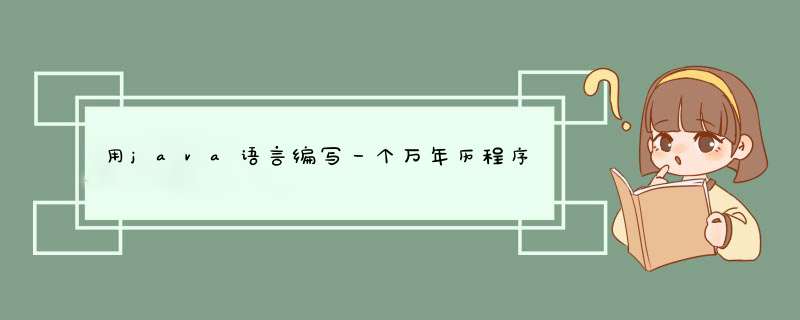
* @(#)AidyCalender.java
*
*
* @author
* @version 1.00 2008/7/19
*/
import java.awt.*
import java.awt.event.*
import java.lang.StringBuffer
import javax.swing.*
import java.util.*
import javax.swing.Timer
import javax.swing.border.*
public class AidyCalender extends JFrame implements ActionListener,ItemListener{
Date date = new Date()
private GregorianCalendar gregorianCalendar = new GregorianCalendar()
//定义中英文字符数组存储星期信息,用于转换显示
private String[] stringWeekEn = new String[] { "SUN", "MON", "TUE", "WED",
"THU", "FRI", "SAT" }
private String[] stringWeekCn = new String[] { "星期日", "星期一", "星期二", "星期三",
"星期四", "星期五", "星期六" }
//定义存储月份的信息数组,用于转换显示方示
private String[] stringMonthEn = new String[] { "Jan", "Feb", "Mar", "Apr",
"May", "Jun", "Jul", "Aug", "Sept", "Oct", "Nov", "Dec" }
private String[] stringMonthCn = {"一月","二月","三月","四月","五月","六月",
"七月","八月","九月","十月","十一月","十二月"}
private String[] sysNowTime = new String[6]//sysNowTime 用于存储系统时间的变量
private String[] sysRunTime = new String[6]
private JLabel []labelWeek = new JLabel[7]
private JLabel []labelDay = new JLabel[42]
private JLabel labelTime = new JLabel()
private JPanel panel1 = new JPanel()
private JPanel panel2 = new JPanel()
private JPanel panel3 = new JPanel()
private JComboBox combo1 = new JComboBox()
private JComboBox combo2 = new JComboBox()
private JButton buttonToday = new JButton()
private Border border = BorderFactory.createRaisedBevelBorder()
private Border border1 = BorderFactory.createLineBorder(Color.cyan,3)
public AidyCalender(String title) {
super(title)
for (int y = 1900y <2101y++) {
combo1.addItem(" " + new Integer(y).toString()+"年")
}
for (int m = 0m<12m++){
combo2.addItem(" "+stringMonthCn[m])
}
buttonToday.setText("今 天")
setLayout(new FlowLayout())
add(panel1)
add(panel2)
add(panel3)
panel1.setLayout(new GridLayout(1,3,10,0))
panel1.add(combo1)
combo1.addItemListener(this)
panel1.add(combo2)
combo2.addItemListener(this)
panel1.add(buttonToday)
buttonToday.addActionListener(this)
labelTime.setFont(new Font("宋体",Font.PLAIN,16))
labelTime.setForeground(Color.MAGENTA)
panel1.add(labelTime)
Timer time = new Timer(1000,new TimerListener())
time.addActionListener(new TimerListener())
//time.setRepeats(true)
time.start()
//labelTime.addAncestorListener(new TimerListener())
panel2.setLayout(new GridLayout(7,7,0,10))
panel2.setBackground(Color.white)
for(int i=0i<7i++){
labelWeek[i] = new JLabel()
labelWeek[i].setHorizontalAlignment(0)
if(i==0||i==6){
labelWeek[i].setBackground(Color.blue)
labelWeek[i].setForeground(Color.RED)
labelWeek[i].setFont(new Font("黑体",Font.BOLD,14))
}
else{
labelWeek[i].setForeground(Color.BLACK)
labelWeek[i].setFont(new Font("新宋体",Font.PLAIN,14))
}
labelWeek[i].setText(stringWeekCn[i])
panel2.add(labelWeek[i])
}
for(int i= 0i<42i++){
labelDay[i] = new JLabel()
labelDay[i].setHorizontalAlignment(0)
labelDay[i].setText("")
panel2.add(labelDay[i])
}
addWindowListener(new WindowAdapter(){
public void windowClosing(WindowEvent e){
System.exit(0)
}
})
setSize(300,300)
setBounds(250, 200, 400, 360)
setVisible(true)
setResizable(false)
setDefaultCloseOperation(JFrame.EXIT_ON_CLOSE)
getSysDate()
setNowDate()
}
public void actionPerformed(ActionEvent ae){
if(ae.getSource()==buttonToday){
setNowDate()
}
}
public void itemStateChanged(ItemEvent aa){
setChangeDate()
}
public int turnWeek(String week){
int i
for(i=0i<7i++)
if(week.equalsIgnoreCase(stringWeekEn[i]))
break
return i
}
public int turnMonth(String month){
/**
*int turnMonth(String month)
*@month 系统日期中的月,诸如Jan\Feb
*@return int
*返回一个整数值,用于寻找stringMonthCn[]数组中对应的中文月份
*/
int i
for(i=0i<12i++)
if(month.equalsIgnoreCase(stringMonthEn[i]))
break
return i
}
/**
*setNowDate()
*设置当前系统日期
*/
public void setNowDate(){
setSysDate(getNowYear(),getNowMonth())
getSysRunDate()
setDateNull()
combo1.setSelectedIndex(getShowYear() - 1900)
combo2.setSelectedIndex(getShowMonth())
setDays(getMonthDays(getNowYear(),getNowMonth()),getInitWeek(sysRunTime[0]),getNowDay())
//labelTime.setText(sysNowTime[3])
//labelTime.setHorizontalAlignment(0)
}
/**Integer getShowYear()
*获取组合框中应该显示的年份
*/
public void setSysDate(int year,int month){
gregorianCalendar.set(year,month,1)
}
public void setDateNull(){
for(int i=0i<42i++){
labelDay[i].setText("")
}
}
public void setChangeDate(){
setSysDate(getComboYear(),getComboMonth())
getSysRunDate()
setDateNull()
setDays(getMonthDays(getComboYear(),getComboMonth()),getInitWeek(sysRunTime[0]),-1)
}
public int getMonthDays(int year, int month) {
/**
*返回所选年月的天数,因为数组中的数值从0开始,所以3\5\8\10分别代表4\6\9\11几个小月.
*而1代表2月,经过是否为闰年判断,选择返回28或29天.
*其余月份为大月,返回31天.
**/
switch (month) {
case 3:
case 5:
case 8:
case 10:
return 30//小月返回30天
case 1:
if (gregorianCalendar.isLeapYear(year)) {
//isLeapYear(year)确定当前纪元中的指定年份是否为闰年。
return 29
} else {
return 28
}//闰年的二月返回29天,平年返回28天
default:
return 31
//大月返回31天
}
}
/**
*int getComboYear()
*获取组合框中的年份
*/
public void getSysDate(){
date = gregorianCalendar.getTime()
sysNowTime = (date.toString()).split(" ")
}
public void getSysRunDate(){
date = gregorianCalendar.getTime()
sysRunTime = (date.toString()).split(" ")
}
public int getComboYear(){
return combo1.getSelectedIndex()+1900
}
/**
*int getComboMonth()
*获取月组合框中的整数值,
*/
public int getComboMonth(){
return combo2.getSelectedIndex()
}
public int getInitWeek(String initWeek){
/**
*getWeekNow(String initWeek)
*@para nowWeek 系统日期中的星期
*返回当月中的1号是从星期几开始
*/
int nowWeek = 0
for(int i = 0i<7i++){
if(initWeek.equalsIgnoreCase(stringWeekEn[i])){
nowWeek = i
break
}
}
return nowWeek
}
public int getNowYear(){
return Integer.parseInt(sysNowTime[5])
}
public int getNowMonth(){
int nowMonth=0
for(int i=0i<12i++){
if(sysNowTime[1].equalsIgnoreCase(stringMonthEn[i]))
nowMonth=i
break
}
return nowMonth
}
public int getNowDay(){
return Integer.parseInt(sysNowTime[2])
}
public Integer getShowYear(){
return Integer.parseInt(sysNowTime[5])
}
public Integer getShowMonth(){
/**
*Integer getShowMonth()
*获取在组给框中显示的中文格式月份:如七月\八月等
*/
return turnMonth(sysNowTime[1])
}
public void setDays(int monthDays,int initWeek,int day){
/**
*void setDays(int monthDays,int initWeek,int day)
*@para monthDays 本月天数
*@para initWeek 初始星期
*@para day 今天日
*设置月历
*/
setDateNull()
for(int i=initWeeki<initWeek+monthDays+1i++){
if((i-initWeek+1)==day){
labelDay[i].setBorder(border1)
labelDay[i].setForeground(Color.BLUE)
labelDay[i].setFont(new Font("黑体",Font.BOLD,20))
}else if((i%7==0)||(i%7==6))
labelDay[i].setForeground(Color.RED)
else{
labelDay[i].setForeground(Color.BLACK)
}
labelDay[i].setText(String.valueOf(i-initWeek+1))
}
for(int i=initWeek+monthDaysi<42i++)
labelDay[i].setText("")
}
class TimerListener implements ActionListener{
//AdapterDemo var=new AdapterDemo("万年历程序--Aidy")
public void actionPerformed(ActionEvent e) {
GregorianCalendar g = new GregorianCalendar()
String clock = new String((g.getTime().toString().split(" "))[3])
labelTime.setText(clock)
}
}
public static void main(String args[])
{
try{
UIManager.setLookAndFeel(UIManager.getSystemLookAndFeelClassName())
}catch(Exception e){
throw new RuntimeException(e)
}
AidyCalender var=new AidyCalender("万年历程序--Aidy")
}
}
本文来自CSDN博客,转载请标明出处:http://blog.csdn.net/aidydream/archive/2008/07/19/2678664.aspx
1、在手机桌面,找到一个空白的界面,然后用手指长时间按住桌面。2、这时候在界面的最下方会d出几个选项,其中第二个叫做添加小工具,选择进入到下一步。
3、找到日历所在的位置,然后,点击一下日历。
4、点击日历之后,会d出相应的内容供选择。
5、选择完毕之后,可以选择相应的式样,背景颜色等等。
6、单击一下日历的位置,就会进入到相关的软件的具体界面。
7、点击之后系统会d出一个下拉菜单。其中第一项为跳转到指定日期,点击。
1、阳历的来历阳历即太阳历,也就是公历,它是国际通用的。我国自民国元年起采用阳历,为与我国旧有之历相对称,阳历又称“新历”。阳历以地球绕太阳转一圈的时间定为一年。共365天5小时48分46妙。平年只计365天这个整数,不计尾数。阳历每年分12个月,大月31天,小月30天,2月只有28天。又规定7月以前,单月为大月,双月为小月;8月以后,双月为大月,而单月为小月。每年所余的5小时48分46秒,只至四年约满一天,这一天就加在第四年的2月里,这一年叫闰年,所以闰年的2月有29天。
2、阳历闰年的确定
一般来说,用4去除阳历的年份,能除尽的就是闰年,像1984、1988年等都是闰年。但是,因为阳历一年的确切天数应该是365天5小时48分46秒,比平年365天多出5小时48分46妙,四年一共多出23小时15分4秒。如果每四年一闰加一天的话,又多了44分56少,四百年差不多就会多加出3天来,所以,每四百年得扣去3天才行。故又订了一条补充规定:每逢阳历年份是整百的那一年,比如公元1800、1900、2000年等,能被400整除,所以不是闰年。但公元2000元又是闰年,因它的2月有29天。
1、阴历的来历
阴历以月亮圆缺一次的时间为一个月,共29天半。为了算起来方便,大月定做30天,小月29天,一年12月中,大小月大体上交替排列。阴历一年有365天左右,也没有平年闰年的差别。
阴历不考虑地球绕太阳的运行,因而使得四季的变化在阴历上就没有固定的时间,它不能反映季节,这是一个很大的缺点。为了克服这个缺点,后来人们定了一个新历法,就是所谓阴阳台历。现在我国还在使用的夏历(也叫农历或阴历)就是这种阴阳合历。它跟阴历一样,以月亮圆缺一次的时间定做一个月,也就是大月30天,小月29天,可是它又用加闰月的办法,使得平均每年的天数跟阳历全年的天数相接近,来调整四季。阴历约每过二三年多有一个闰月。
2、阴历闰月的确定
至于阴历哪一个月,这就牵涉到了节气了。说一年有二十四节气,只是一种传统的说法,往细方面说,应该说一年有十二个节气和十二个中气。这十二个中气,哪个中气属于哪个月,是有规定的:雨水是正月的中气;春分是二月的中气;谷雨是三月的中气;小满是四月的中气;夏至是五月的中气;大暑是六月的中气;处暑是七月的中气;秋分是八月的中气;霜降是九月的中气;小雪是十月的中气;
欢迎分享,转载请注明来源:内存溢出

 微信扫一扫
微信扫一扫
 支付宝扫一扫
支付宝扫一扫
评论列表(0条)